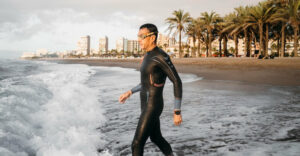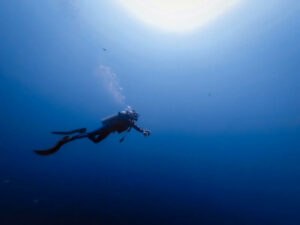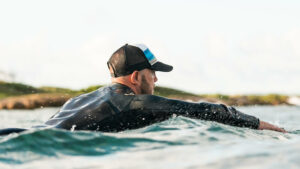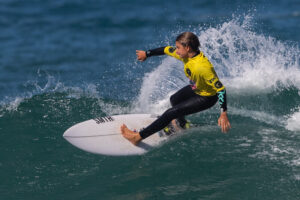Speed, finesse, and all powered by the collaboration of wind and waves. Kite and board. Human and elements. Kitesurfing vs kiteboarding have a lot in common. Actually, they have so much in common, it gets hard to not lose sight over ‘what is what’.
These two water sport terms, often used interchangeably, each possess unique characteristics that set them apart and cater to diverse preferences among water sports enthusiasts. Swift changes in the gear, different techniques and two distinct requirements for the location to practice kitesurfing vs kiteboarding. In the following, we will give you a comprehensive clarification of the two terms, making sure you will never again have trouble differentiating kitesurfing vs kiteboarding.
In this article, you will get answers to the following questions:
- Do many people struggle with the kitesurfing vs kiteboarding difficulty?
- How does the equipment vary between kitesurfing vs kiteboarding?
- What is the main difference between kite surfing and kiteboarding?
- Can one derive one surfing style skill from the other?
Kitesurfing vs Kiteboarding – a Linguistic Sea of Confusion
While these terms are frequently used interchangeably, a subtle yet significant difference underlies their usage, and a common mistake emerges in the terminology tide. There is no way of telling you which of the two is the better sport. But maybe after learning a bit more about these two ways to surf, you will not only be able to tell them apart perfectly, but to decide yourself, which one suits you personally better as well. So let’s start by grasping the basic What is What of kitesurfing vs kiteboarding.
Here are the main key points to compare kitesurfing vs kiteboarding:
➀ History and Culture
➁ Location Requirements
➂ Technique
➃ Equipment and Safety
Kitesurfing vs Kiteboarding: History and Culture
In essence, the histories of kite surfing and kiteboarding share a common origin, with the Legaignoux brothers’ innovations being foundational to both. In this exploration, we’ll delve into the historical roots and cultural dimensions that have shaped these two water sport siblings, kitesurfing vs kiteboarding.
The Origin
The seeds of kite surfing were sown in the late 1970s and early 1980s, a period marked by the innovative spirit of water sports enthusiasts. Domina Jalbert, a French inventor, is often credited with the creation of the ram-air inflatable kite, a pivotal development that laid the groundwork for kitesurfing vs kiteboarding
The true inception of kite surfing is attributed to the efforts of two brothers, Bruno and Dominique Legaignoux, in the late 20th century.
In the mid-1980s, they patented an inflatable kite design known as the Wipika. This breakthrough kite design, characterized by an inflatable leading edge, provided the necessary lift and control for riding the waves.
Era of Experimentation
The fledgling years of kite surfing were not without challenges. Riders grappled with issues of control and safety, pushing the sport’s pioneers to refine equipment designs and safety mechanisms.
By the late 1990s and early 2000s, advancements in kite design, control bars, and safety releases contributed to a more stable and user-friendly kite surfing experience.
Global Popularity
Kite surfing rapidly expanded its reach across the globe during the late 1990s and early 2000s. Beaches and coastlines became playgrounds for riders drawn to the thrill of harnessing the wind to propel them across the water.
The 21st century witnessed the emergence of kiteboarding as a competitive sport. From freestyle competitions showcasing aerial acrobatics to the adrenaline-fueled discipline of big air, riders began pushing the boundaries of what was thought possible on the water.
And with the sport expanding, the equipment enhancing and the crowd growing, more and more clearly distinct subgroups emerged.
The Separation of Kitesurfing vs Kiteboarding
The term “kite surfing” has its roots in the early days of the sport. It emphasizes the synergy between the kite and the surfboard, highlighting the rider’s ability to use the power of the kite to navigate waves.
On the other hand, “kiteboarding” emerged as a term that encompasses a broader spectrum of riding styles beyond just waves. As the sport evolved, riders began exploring various disciplines, including freestyle, freeride, and big air, which expanded the scope beyond traditional wave riding.
Kite surfing Culture
The culture surrounding kite surfing and kiteboarding is a vibrant and dynamic community that unites individuals and subgroups with a shared passion for harnessing the wind and riding the waves.
The kite surfing and kiteboarding community is known for its creative spirit, pushing the boundaries of what is possible in the air and on the waves. From freestyle tricks to big air jumps, kite surfing culture embodies a daring and progressive ethos.
While kitesurfing vs kiteboarding have distinct goals in their sport, they share commonalities in their evolution as wind-driven water sports. They influence each other, exchange inspiration and after all, share one passion: the love to the winds, the ocean, and the adrenaline that is born of the connection between the two.
Kitesurfing vs Kiteboarding: Location Requirements
Water. Wind. What else? Kitesurfing vs kiteboarding reaches its fork in the road exactly here. While one depends on the force of the ocean with its swells and tides, the other one can be practiced on nearly mirror-smooth water surface. Learn the biggest difference between kitesurfing and kiteboarding right here!
Kite surfing: Riding the Waves
Kite surfing, as the name suggests, traditionally emphasizes the synergy between the kite and the surfboard, particularly in a wave-riding context. Optimal locations for kite surfing often include:
Coastal Areas with Waves: Kite surfers thrive in coastal locations with consistent waves. These spots provide the ideal canvas for executing fluid turns, jumps, and maneuvers, showcasing the dynamic relationship between the kite and the surf.
Wind and Wave Alignment: Kite surfing locations benefit from a harmonious alignment of wind and waves. Riders seek areas where prevailing winds create consistent, rideable waves.
Open Ocean or Bays: Riders looking for a more challenging experience may venture into open ocean settings or expansive bays where larger, more powerful waves challenge their skills and push the boundaries of wave riding.
Kiteboarding: Versatility Across Terrains
Kiteboarding encompasses a broader spectrum of riding styles, including freestyle, free ride, and more. The sport’s versatility allows for a range of ideal locations:
Flat Water Spots: Kite boarders often seek locations with flat water, such as lagoons, estuaries, or shallow coastal areas. These spots provide an optimal playground for executing tricks, jumps, and freestyle maneuvers without the interference of waves.
Inland Waterways: Inland locations, including lakes and rivers, can be suitable for kiteboarding. The absence of waves in these settings allows riders to focus on flat water techniques and explore the sport’s creative dimensions.
Consistent Wind Conditions: Both kite surfing and kiteboarding thrive in locations with reliable and consistent wind patterns. Coastal areas, open water, and wide expanses contribute to an uninterrupted flow of wind, creating an ideal setting for both disciplines.
Kitesurfing vs Windsurfing: Technique
In the realm of kitesurfing vs kiteboarding, techniques serve as the gateway to mastering the elements. Wave riding in kite surfing is an art that demands finesse and a deep connection with both wind and water. Kiteboarding, on the other hand, with its versatile nature, encompasses various riding styles.
Whether kite surfing or kiteboarding, riders navigate the waters with a blend of skill, finesse, and a deep connection to the ever-changing winds.
Launching
Kite surfers commonly perform beach launches, where they position the kite on the sand. With the kite facing the water, the surfer carefully controls the lines to launch the kite into the wind.
Timing is crucial in kite surfing launches, especially when riding waves. Launching at the opportune moment, often coordinating with a wave’s motion, ensures a smooth takeoff and minimizes the risk of the kite losing wind.
In some scenarios, kite surfers may opt for an assisted launch, where a fellow surfer or beach helper assists in controlling the kite as it ascends into the wind. Kite surfers pay careful attention to the positioning of the kite in relation to the wind and waves during launch. Proper kite control sets the stage for a seamless transition from the shore to the open water.
Kiteboarding launches unfold on flat water, and the techniques employed differ to suit these conditions. Kite boarders often perform water launches, starting from a floating position. With the kite positioned overhead, riders use their board and body movements to generate power and lift the kite into the wind.
While the launching techniques differ between kitesurfing vs kiteboarding, both disciplines prioritize safety measures. Riders ensure that lines are clear, equipment is properly rigged, and communication is established to create a secure environment for launching into the wind.
Jumps and Turns
In kite surfing, jumps are often integrated into wave-riding maneuvers. Timing the takeoff with the crest of a wave allows riders to achieve greater height and perform stylish aerial tricks.
A well-executed bottom turn sets the stage for a powerful jump in kite surfing. Riders use the motion of the wave to initiate the turn, generating speed and lift for the jump.
Advanced kite surfers may choose to land their jumps on the face of a wave, seamlessly integrating aerial tricks with wave-riding skills. The ability to land on a moving surface adds an extra layer of complexity and style.
Kite boarders initiate jumps with a combination of a board pop and a strong edge against the wind. Popping the board off the water generates lift, while a well-timed edge directs the board into the wind for controlled flight.
Kiteboarding jumps often involve a variety of aerial maneuvers, including spins, grabs, and flips. Riders showcase their creativity and skill by combining different tricks during the jump sequence.
Unlike kite surfing, where landings may occur on waves, kite boarders typically aim for flat water landings. Achieving a smooth landing involves controlling the kite and adjusting the board for a gentle touch down.
Both styles, kitesurfing vs kiteboarding, bend their knees upon landing to absorb the impact. This absorption technique minimizes stress on the body and enhances overall comfort during landings.
Key Difference between Kitesurfing and Kiteboarding Techniques
Kite surfing focuses on riding the waves. Techniques include navigating the surf, timing maneuvers with wave crests and troughs, and utilizing the energy of the waves for jumps and turns. Bottom turns, performed at the bottom of the wave, set up the rider for a powerful ascent. Top turns, executed at the wave’s crest, showcase the rider’s ability to harness the wind for fluid maneuvers.
Kite surfers leverage the energy of waves to boost their jumps. Timing the takeoff with the crest of a wave allows for higher jumps and more dynamic aerial maneuvers. Controlling the kite in the presence of waves is a key skill in kite surfing. Riders need to manage the kite’s position to adapt to the changing wind conditions and undulating water surfaces.
Kiteboarding encompasses a broader range of riding styles, including freestyle, free ride, wake style, and big air. Techniques involve executing tricks and jumps on flat water, showcasing creativity and skill in aerial maneuvers.
In certain freestyle disciplines of kiteboarding, riders may incorporate “board-off” techniques, temporarily detaching one or both feet from the board midair during jumps, adding a stylish and daring dimension to their performance.
Kite boarders often need to ride upwind efficiently, especially in flat water conditions. Techniques include using the kite’s power and adjusting the board’s angle to navigate against the wind.
Despite these distinctions, it’s important to note that many techniques overlap between kitesurfing vs kiteboarding. Both activities share fundamental skills such as kite control, body positioning, and board manipulation. Riders often transition between different styles based on conditions and personal preferences
Kitesurfing vs Windsurfing: Equipment and Safety Essentials
It’s important to note that the distinctions are generalizations, and there is significant overlap in equipment between kitesurfing vs kiteboarding.
Riders often choose their equipment based on personal preferences, local conditions, and the specific style of riding they enjoy.
The lines between kitesurfing vs kiteboarding equipment are fluid, reflecting the diverse and evolving nature of the sport.
The Board
The Kite surfboard is often designed with wave riding in mind. They may have a directional shape similar to traditional surfboards, allowing riders to navigate and carve through waves with ease.
The tail and rail design of kite surfing boards is often optimized for turning on the face of waves. A narrower tail and specific rail contours enhance maneuverability in the dynamic conditions of the surf.
Tri-fin setups or quad-fin setups are common, providing stability and control while riding waves. Kite surfing boards may have a specific flex pattern to handle the changing contours of waves. The flex allows the board to adapt to the wave’s shape, providing a smoother ride.
Kiteboarding boards commonly feature a twin-tip design, which is symmetrical and allows riding in both directions without turning the board around. This design is versatile and well-suited for various riding styles, including freestyle, free ride, and big air.
Twin-tip kiteboards often have a flat bottom, providing stability and ease of planning on flat water. The flat shape allows for smooth transitions and easy control during tricks.
Kite boarders typically use bindings or foot straps to secure their feet to the board. This provides better control during jumps and tricks, allowing riders to leverage the kite’s power for aerial maneuvers.
The Kite
The kite is typically inflatable and consists of a leading edge and struts that give it structure. Inflatable bladders provide buoyancy and shape to the kite when inflated.
They come in various sizes, typically ranging from 5 to 17 square meters. The size of the kite influences its power and performance, with smaller kites suitable for higher winds and larger kites for lighter winds. Just like for a surfboard, when adjusting the surfboard’s size to the size and power of the waves.
The kite is controlled by a control bar held by the rider. The control bar is connected to the kite by lines. Manipulating the control bar allows the rider to steer the kite, control its angle of attack, and adjust the power.
Kite surfers may prefer kites specifically designed for wave riding. Wave kites typically have characteristics such as quick turning ability, depower, and drift to allow the rider to navigate the kite through the dynamic and changing conditions of the waves.
In kite surfing setups, riders may opt for slightly shorter lines compared to kiteboarding setups. Shorter lines can provide more direct and responsive control, which is beneficial in the dynamic and challenging environment of wave riding.
Kite boarders may choose kites that offer versatility across different conditions and riding styles. All-around kites are designed to perform well in various scenarios, from flat water freestyle to big air jumps.
Safety Mechanisms
While the basic safety mechanisms, such as leash, quick release and depower systems, are similar, there can be some discipline-specific considerations.
In kite surfing, where riders navigate waves, there might be an increased emphasis on techniques for relaunching kites from the water in challenging conditions. In kiteboarding, especially in freestyle disciplines, riders may focus on additional safety features that facilitate quick recoveries after performing tricks or jumps.
Conclusion: What is the Difference between Kitesurfing and Kiteboarding?
Kitesurfing vs kiteboarding, while sharing the commonality of harnessing the wind for spectacular turns and jumps on the water, offer distinct experiences driven by their equipment, techniques, and the choice of terrain. In summary, the key difference between “kite surfing” and “kiteboarding” often lies in historical and regional contexts, with “kite surfing” being associated more with wave riding and “kiteboarding” having a broader connotation that includes various riding styles beyond waves.
In the end, the decision for one or the other is the real kitesurfing vs kiteboarding difficulty. But luckily, you are free to try out both and combine your next vacation not only with a jaw dropping surf spot visit, but maybe even with new hobbies to try out in the water.
FAQ – Most Asked Questions about Kitesurfing vs Kiteboarding
In general usage, the terms are often interchangeable. However, some regions or individuals may use “kite surfing” to refer specifically to riding waves with a surfboard, while “kiteboarding” is a more inclusive term that encompasses various riding styles beyond waves.
Yes, many riders use the same kite for both activities. Modern kites are designed to be versatile and suitable for various riding styles. It’s essential to choose the right size based on wind conditions and personal preferences.
Wave riders in kite surfing benefit from the natural energy and flow of the waves. The ability to carve and turn on the face of the wave provides a unique sense of freedom and creativity. But kiteboarding, with its versatility in riding styles, allows for freedom of movement in various scenarios. Riders can engage in freestyle tricks, big air jumps, and free ride cruising, each offering a distinct experience.
The short answer is, None! Both kite surfing and kiteboarding offer entry points for beginners. Choosing between them might depend on personal preferences and local conditions.
Kite surfing and kiteboarding hotspots are destinations renowned for their favorable wind conditions, diverse riding opportunities, and vibrant kiteboarding communities. Famous places to kite surf are i.e. Tarifa in Spain, Cumbuco in Brazil, Maui in the USA or El Gouna in Egypt.









